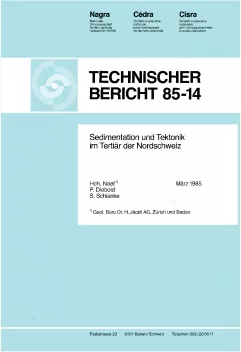
Technischer Bericht NTB 85-14
Sedimentation und Tektonik im Tertiär der Nordschweiz
The following literature study of the Tertiary of northern Switzerland and its surroundings presents an approach to the problem "sedimentation and tectonics" in the region. As a first fundamental step information has been gathered for the compilation of five Iitho- and chronostratigraphical correlation charts of the postsiderolithic sediments of northern Switzerland s .l. (Chapter 2.2 and Appendix). Uncertainties remain comparing and correlating the different local and regional interpretations of these Tertiary deposits; they cannot always be resolved in a satisfactory manner.
In a second part, schematic geological sections have been constructed and then divided into distinct stratigraphic units (Enclosures 5 + 6). Subsidence curves (Fig. 3) have been determined for a series of points along each section. From those, three-dimensional diagrammes of temporal and spatial vertical tectonic movements since the upper Eocene have been reconstructed (Fig. 5).
These reconstructions indicate that
a) A relatively independent and complicated interference zone extends between the constantly subsiding Molasse through and the rather stable mesoeuropean foreland (Tabular Jura, Black Forest, Swabian Alp). It obviously forms a transition zone between the alpine tectonic realm and the forces which emanate from the Rhinegraben riftsystem and the Black forest.
b) The subsidence curves, together with many hints in published reports, strongly suggest several distinct tectonic phases in northern Switzerland. A Synopsis of the events since upper Eocene time is attempted.
c) Some quantitative aspects of the observed tectonic movements in the Tertiary of northern Switzerland and in other well documented regions are discussed and compared with modern geodetic data. Roughly two main tectonic settings can be distinguished:
- Relatively narrow areas with rather local and episodic movements. For example the formation of graben structures and other fault patterns where rates of differential mouvements could be relatively high.
- Wide areas with steady movements during longer periods of time. For example the doming downwarping of lithospheric crust, regional isostatic adjustments and probably horizontal nappe displacements with velocities of up to a few mm/year.
